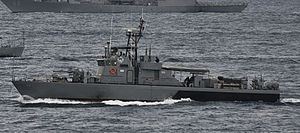Tomas Batilo-class patrol craft
 BRP Salvador Abcede, a Tomas Batilo-class patrol craft | |
| Class overview | |
|---|---|
| Name: | Tomas Batilo class |
| Builders: | Korea Tacoma Shipyard, Chinhae, South Korea |
| Operators: | |
| In service: | 1996 - present |
| Active: | 4 |
| Lost: | 2 |
| General characteristics | |
| Type: | Fast attack craft |
| Displacement: | 148 tons full load[1][2] |
| Length: | 121.4 ft (37 m) |
| Beam: | 22.6 ft (7 m) |
| Draft: | 5.6 ft (1.7 m) |
| Installed power: | 5,800 hp (4,300 kW) |
| Propulsion: | 2 × Caterpillar 3516C diesel engines at 6,300 hp (4,700 kW), 2 shafts (for PG-111,114,116-118[3] or 2 MTU MD 16V 538 TB90 diesel engines at 6,000 hp (4,500 kW) (for PG-110, 112, 115).[1] |
| Speed: | 33 knots (61 km/h) max |
| Range: | 600 nautical miles (1,100 km) at 20 kn (37 km/h; 23 mph) |
| Boats & landing craft carried: | 1 × Rigid Hull Inflatable Boat |
| Complement: | 31 |
| Sensors and processing systems: | Koden Electronics MDC 1500 series navigation and surface search radar[3] |
| Armament: |
|
| Armour: | Upgraded boats have armored windshields |
The Tomas Batilo class is a ship class of eight patrol boats currently in service of the Philippine Navy. These ships were formerly used by the South Korean Navy as Chamsuri/Wildcat (PKM-200 series) class fast attack crafts. Only four ships are still in active service, with two units lost in separate incidents while the rest are scrap for spare part.
Contents
1 History
2 Ships in class
3 Gallery
4 References
5 External links
History
Formerly Chamsuri - Wildcat class fast attack crafts of the South Korean Navy built in the 1970s, with Korean designation as Patrol Killer Medium (PKM). South Korea transferred the former ROKN ships to the Philippine government, with the first batch of five units namely the former PKM-225, 226, 229, 231, and 235 which were handed-over on 15 June 1995, and arrived in Manila in August 1995.[4][5] This batch became the following ships: BRP Tomas Batillo (PG-110) ex-PKM 225; BRP Boni Serrano (PG-111) ex-PKM 226; BRP Bienvenido Salting (PG-112) ex-PKM 229; BRP Salvador Abcede (PG-114) ex-PKM 231; and BRP Ramon Aguirre (PG-115) ex-PKM 235. Except for PG-115 which was used as spares after being written-off during a delivery accident, all where commissioned to the Philippine Navy on 22 May 1996.[4]
Another PKM was delivered to the Philippine Navy in 1998[6] and was originally for spares, but this was activated by the Philippine Navy on 2 July 1998 which became BRP Nicolas Mahusay (PG-116).[4]
The South Korean government granted a request by the Philippines to transfer another two units in 2004, and PKM 223 and PKM 232 was handed-over to the Philippine government in 2005, and was transferred from Chinhae Naval Base in Busan, South Korea, to Manila, Philippines, arriving on 30 May 2006.[3] ex-PKM 232 was commissioned as BRP Dionisio Ojeda (PG-117) in 2007, while PKM 223 was commissioned as BRP Emilio Liwanag (PG-118) on 15 April 2008.[7]
Ships in class
| Pennant number | Ship name | Acquired | Commissioned | Service | Status |
|---|---|---|---|---|---|
| PG-110 | BRP Tomas Batilo | 15 June 1995 | 22 May 1996 | Philippine Navy Patrol Force | Sunk by typhoon in 2003, raised in 2009, sold for scrap[8] |
| PG-111 | BRP Boni Serrano | 15 June 1995 | 22 May 1996 | Philippine Navy Littoral Combat Force | Active, upgraded 2006-2008 |
| PG-112 | BRP Bienvenido Salting | 15 June 1995 | 22 May 1996 | Philippine Navy Littoral Combat Force | Decommissioned 31 October 2018 |
| PG-114 | BRP Salvador Abcede | 15 June 1995 | 22 May 1996 | Philippine Navy Littoral Combat Force | Active, upgraded 2009-2010 |
| PG-115 | BRP Ramon Aguirre | 15 June 1995 | not commissioned | Philippine Navy Patrol Force | Accidentally damaged beyond economic repair during deliveries in 1995. Became parts hulk for sister ships. |
| PG-116 | BRP Nicolas Mahusay | 1998 | 2 July 1998 | Philippine Navy Littoral Combat Force | Active, upgraded 2006-2008. Originally for parts hulk, but was activated due to need for more active ships.[6] |
| PG-117 | BRP Dionisio Ojeda | 30 May 2006 | 2007 | Philippine Navy Littoral Combat Force | Decommission Disassemble into parts hulks to be cannibalize |
| PG-118 | BRP Emilio Liwanag | 30 May 2006 | 15 April 2011 | Philippine Navy Littoral Combat Force | Active, upgraded prior to commissioning |
Gallery

BRP Salvador Abcede with other US and Philippine ships at CARAT Philippines 2012

BRP Nicolas Mahusay at CARAT Philippines 2008

BRP Dionisio Ojeda during search and rescue operations
References
^ ab Saunders, Stephen (2004). Jane's Fighting Ships 2004-2005 (107th ed.). Jane's Information Group Ltd..mw-parser-output cite.citation{font-style:inherit}.mw-parser-output .citation q{quotes:"""""""'""'"}.mw-parser-output .citation .cs1-lock-free a{background:url("//upload.wikimedia.org/wikipedia/commons/thumb/6/65/Lock-green.svg/9px-Lock-green.svg.png")no-repeat;background-position:right .1em center}.mw-parser-output .citation .cs1-lock-limited a,.mw-parser-output .citation .cs1-lock-registration a{background:url("//upload.wikimedia.org/wikipedia/commons/thumb/d/d6/Lock-gray-alt-2.svg/9px-Lock-gray-alt-2.svg.png")no-repeat;background-position:right .1em center}.mw-parser-output .citation .cs1-lock-subscription a{background:url("//upload.wikimedia.org/wikipedia/commons/thumb/a/aa/Lock-red-alt-2.svg/9px-Lock-red-alt-2.svg.png")no-repeat;background-position:right .1em center}.mw-parser-output .cs1-subscription,.mw-parser-output .cs1-registration{color:#555}.mw-parser-output .cs1-subscription span,.mw-parser-output .cs1-registration span{border-bottom:1px dotted;cursor:help}.mw-parser-output .cs1-ws-icon a{background:url("//upload.wikimedia.org/wikipedia/commons/thumb/4/4c/Wikisource-logo.svg/12px-Wikisource-logo.svg.png")no-repeat;background-position:right .1em center}.mw-parser-output code.cs1-code{color:inherit;background:inherit;border:inherit;padding:inherit}.mw-parser-output .cs1-hidden-error{display:none;font-size:100%}.mw-parser-output .cs1-visible-error{font-size:100%}.mw-parser-output .cs1-maint{display:none;color:#33aa33;margin-left:0.3em}.mw-parser-output .cs1-subscription,.mw-parser-output .cs1-registration,.mw-parser-output .cs1-format{font-size:95%}.mw-parser-output .cs1-kern-left,.mw-parser-output .cs1-kern-wl-left{padding-left:0.2em}.mw-parser-output .cs1-kern-right,.mw-parser-output .cs1-kern-wl-right{padding-right:0.2em}
^ Wertheim, Eric (2007). The Naval Institute Guide to Combat Fleets of the World (15th ed.). Naval Institute Press. pp. 552–53.
^ abc AFP Materiel Technical Specification Archives - PN Light Surface Warships Batilo (Sea Dolphin/PKM 200 'Chamsuri') class Small Patrol Craft (7)
^ abc "PG Tomas Batillo Class". globalsecurity.org. Retrieved 17 May 2016.
^ ab "PKM 200 Sea Dolphin (Wild Cat) class patrol boats". Jane's. Retrieved 2012-08-29.
^ Sealift MSC August 2009 Safeguard salvages Filipino patrol boat
External links
- Philippine Navy Official website


